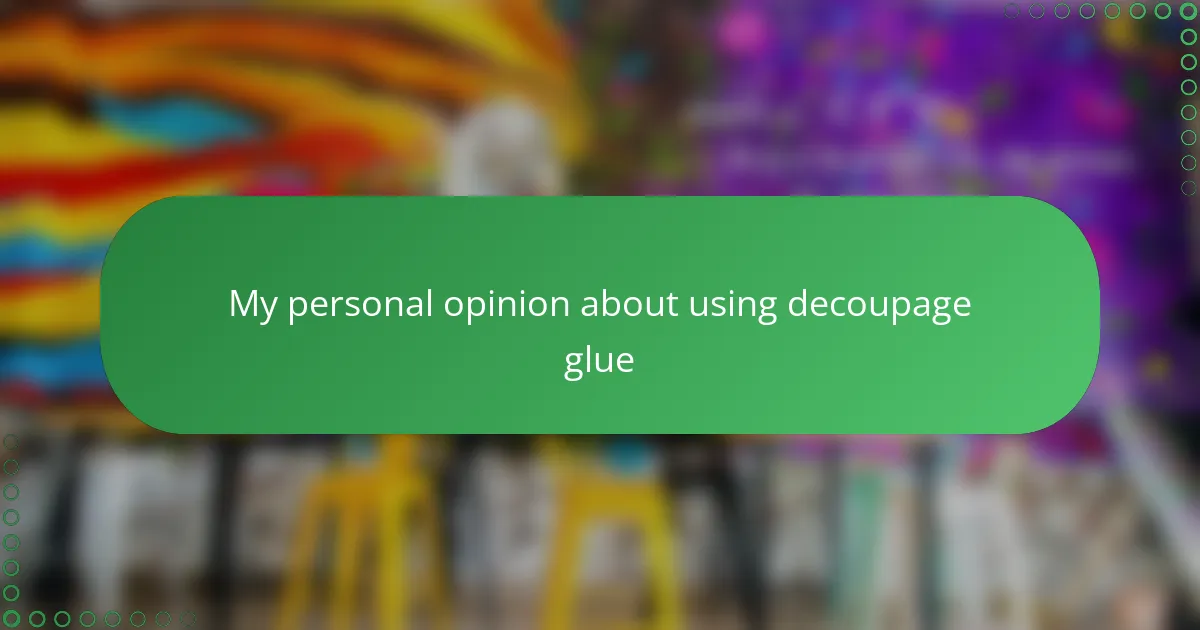Key takeaways
- Decoupage glue acts as both an adhesive and sealer, simplifying the crafting process by eliminating the need for multiple products.
- It creates a durable, water-resistant finish that enhances colors and textures, offering a glossy sheen that elevates craft projects.
- Applying thin, even layers and ensuring adequate drying time are crucial for achieving a flawless, professional-looking finish.
- Common issues include bubbles under the paper and uneven finishes, which can be mitigated by using soft tools for smoothing and being patient during the drying process.
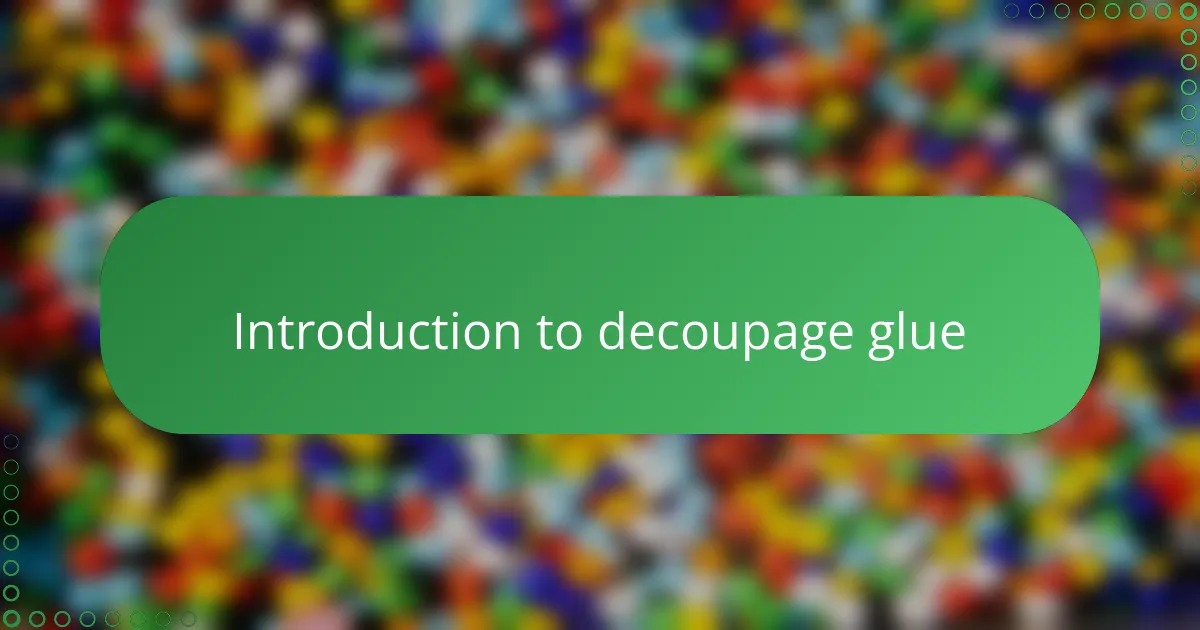
Introduction to decoupage glue
Decoupage glue is more than just an adhesive—it’s the magic that brings paper crafts to life. When I first started using it, I was amazed by how smoothly it applied and how well it preserved the delicate designs I wanted to showcase. Have you ever struggled with a glue that ruins your paper or dries too sticky? That’s where decoupage glue truly shines.
What fascinates me about decoupage glue is how it acts both as glue and sealer. I’ve found that this dual action saves so much time and effort during crafting sessions. Instead of juggling multiple products, one bottle does the job, making the whole process simpler and more enjoyable.
At its core, decoupage glue is specially formulated to maintain the vivid colors and textures of paper, preventing unwanted wrinkles or bubbles. From my experience, this quality creates a smooth, professional finish that always impresses. Isn’t it satisfying when your handmade project looks just as you imagined—if not better?
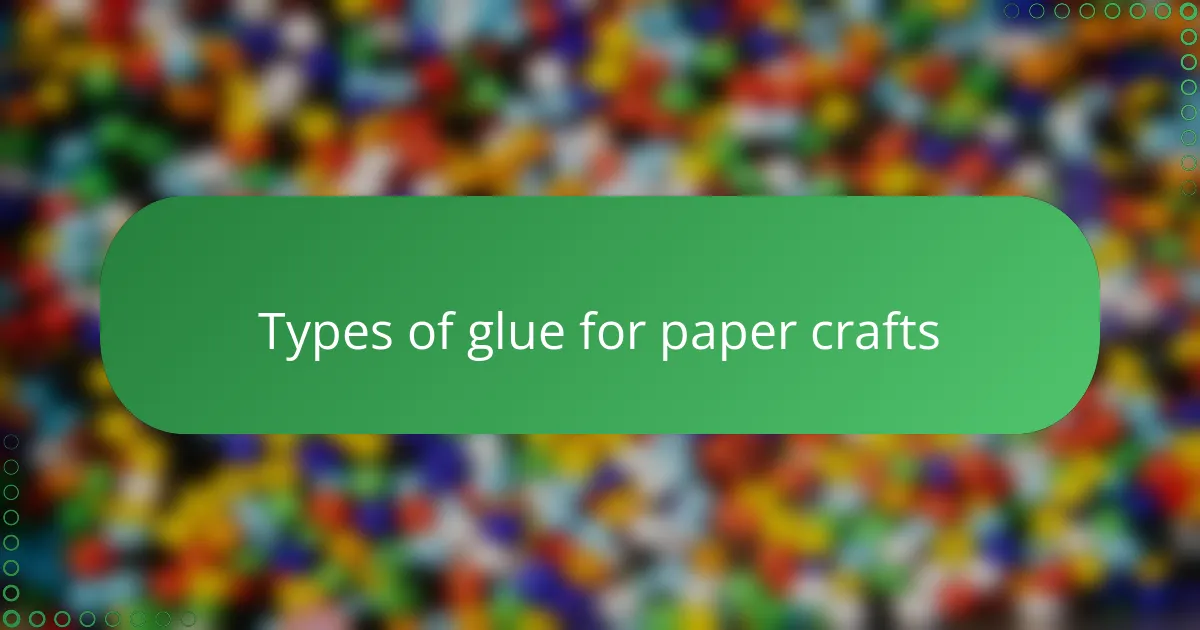
Types of glue for paper crafts
When I first explored the world of paper crafts, I quickly realized that not all glues are created equal. Standard white glue, for example, is easy to find and fairly inexpensive, but I noticed it often soaks into the paper, causing wrinkles or warping that spoil the final look. Have you ever had a beautiful sheet distort after applying glue? That experience taught me to be more selective about my adhesives.
Then there are glue sticks, which I used for quick projects and layering paper. They’re tidy and dry fast, yet I always felt they lacked the strong hold required for pieces that needed durability or multiple layers. From my perspective, they’re great for scrapbooking or simple collages but don’t offer the versatility decoupage glue provides.
Mod Podge and similar decoupage glues quickly became my go-to because they combine adhesion with sealing qualities. What I appreciate most is how forgiving it is—allowing me to reposition paper slightly before it sets and, once dry, creating a protective, glossy finish. Have you ever wished your glue could do more than just stick things together? That’s exactly why I keep coming back to decoupage glue in my paper crafting journey.

Benefits of using decoupage glue
One of the biggest benefits I’ve experienced with decoupage glue is its ability to create a durable, water-resistant finish. I remember a project where I accidentally spilled a little water on my paper design, and to my surprise, the decoupage glue protected it without any damage. Isn’t it comforting to know your handmade craft can withstand little accidents like that?
Another thing I truly value is how decoupage glue dries clear and smooth, enhancing the colors and textures rather than dulling them. When I apply it, I always get that satisfying glossy sheen that makes each detail pop, bringing my work to life in a way that other glues just don’t achieve. Have you noticed how a subtle shine can elevate even the simplest design?
Lastly, the versatility of decoupage glue makes it a staple in my craft kit. Whether I’m working on delicate paper layering or sealing a finished piece for gifting, its multitasking quality saves me from juggling multiple products. I find myself enjoying the process more, knowing this single glue supports so many creative ideas with such ease. Doesn’t that kind of reliability make crafting just that much more enjoyable?
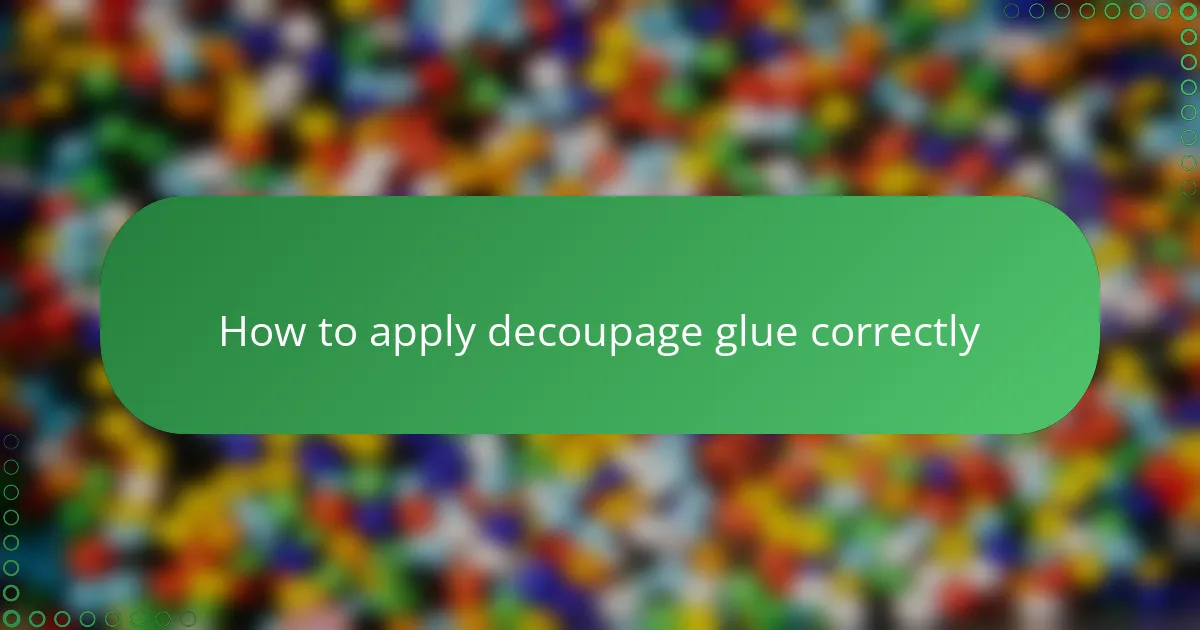
How to apply decoupage glue correctly
Applying decoupage glue correctly can make all the difference between a flawless finish and a frustrating mess. From my experience, the key is to use a thin, even layer—too much glue and the paper can wrinkle or bubble, too little and it won’t stick properly. Have you ever tried spreading glue in thick clumps only to see your design warp? That was a lesson I learned the hard way.
I usually start by brushing the glue onto the surface first, then gently placing the paper on top. This method lets me avoid trapping air pockets, which used to drive me crazy in earlier projects. If you take your time to smooth the paper with a soft brush or even a clean sponge, you’ll get that beautifully seamless look that’s so satisfying to see.
Once the paper is in place, I always apply a second thin coat over the top to seal everything in. Waiting for each layer to dry properly is crucial—patience really pays off here. Do you know that moment when your project dries clear and glossy, and you realize all the effort was worth it? That feeling never gets old for me.
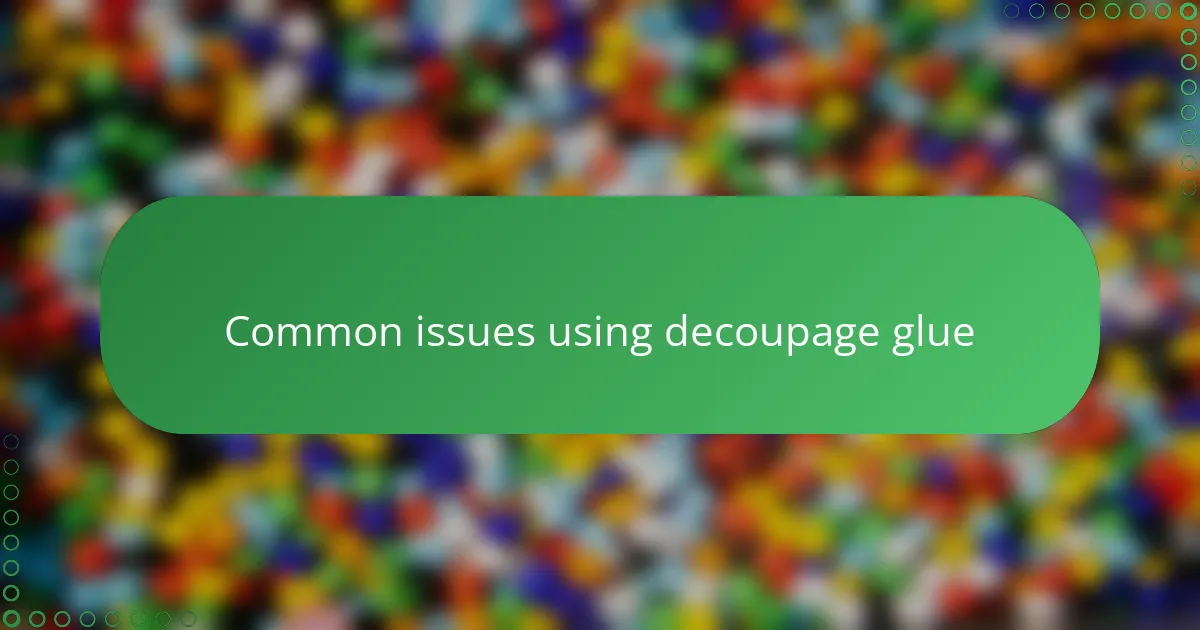
Common issues using decoupage glue
One common issue I’ve encountered with decoupage glue is the frustrating appearance of bubbles under the paper. No matter how carefully I apply it, those tiny air pockets sometimes sneak in, making the surface look uneven. Have you ever spent more time smoothing than gluing? From my experience, gently pressing with a soft tool right after placement helps, but patience is key.
Another challenge is the drying time. I’ve noticed that if I rush the process, the glue can remain tacky or even cause the paper to lift later. It used to annoy me when I thought my craft was finished, only to see edges peeling days after. Waiting for each layer to dry completely, though sometimes tedious, really makes a difference in achieving a lasting finish.
Sometimes, the glue’s finish can turn out less glossy than I hoped, especially if I apply too thickly. I remember one project where the surface looked dull and uneven, which was a tough lesson on moderation. Have you ever been surprised by how the amount of glue changes the final look? For me, learning to apply just the right amount became a small art in itself.
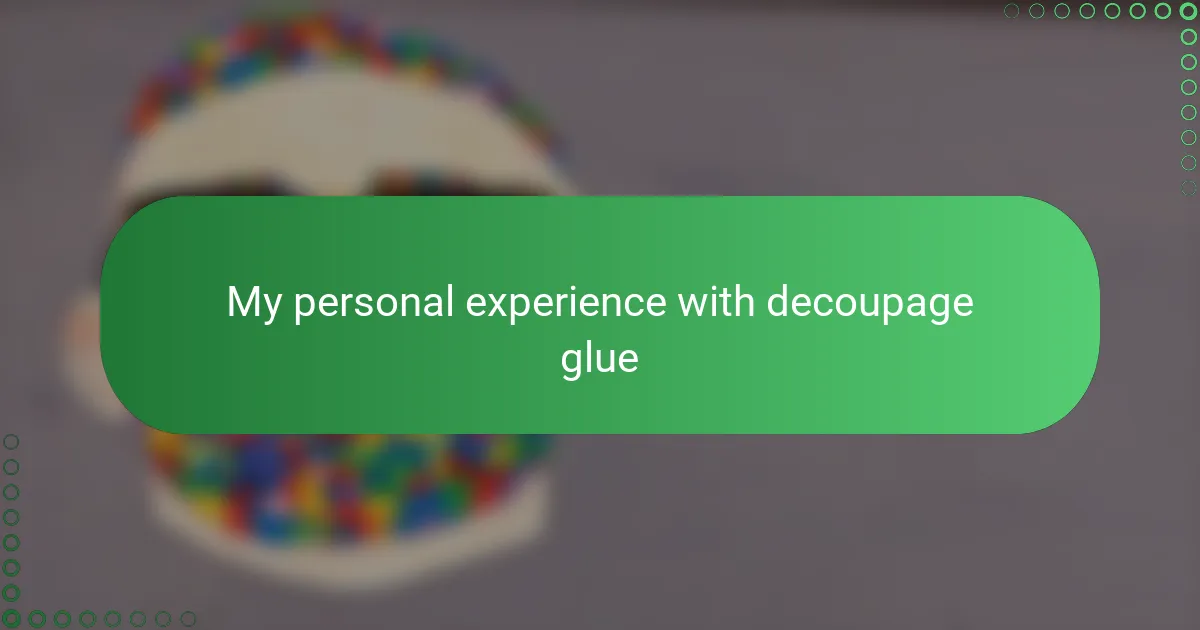
My personal experience with decoupage glue
When I first tried decoupage glue, I was a bit hesitant—what if it was just another product that promised more than it delivered? But to my pleasant surprise, it worked like a charm right from the start. I still remember how thrilled I felt when a tricky layered paper project held up perfectly without any wrinkles or peeling; that little win made me a true believer.
There was this one afternoon when I accidentally knocked over my cup of water onto a freshly glued craft. My heart sank, but then I noticed no damage at all—the glue had created this invisible shield. That moment convinced me that decoupage glue isn’t just an adhesive; it’s a protector for my hard work. Have you ever experienced that kind of relief when a craft you care about stays intact against the odds?
Of course, not every experience has been flawless. I learned the hard way that rushing the drying time leads to frustrating results like tackiness or bubbling. I found that patience was my best friend, even if it meant pausing my enthusiasm to let each layer set properly. Does anyone else find waiting so difficult when you’re excited about crafting? I certainly do, but those extra minutes always pay off.

Tips for best results with decoupage glue
One tip I’ve come to trust is to always use thin, even layers of decoupage glue. Thick coats tend to trap air bubbles or cause wrinkles—a mistake I made more than once early on. Have you ever peeled back a bubbled-up paper only to sigh in frustration? Spreading gently with a soft brush or sponge really helps avoid that.
Another thing I’ve learned is the importance of patience between layers. I used to rush, eager to finish, but noticed my edges lifting or the surface staying tacky. Waiting for each coat to dry fully feels like a slow step, but isn’t that moment when you uncover a smooth, glossy finish completely worth it? That little pause saved many of my projects.
Lastly, smoothing the paper right after placing it has become my favorite satisfying part. Pressing gently with a soft tool eliminates trapped air pockets and sets the design perfectly flat. Have you ever felt that moment of relief when the paper just clicks into place without any bubbles? It’s honestly one of the most rewarding parts of working with decoupage glue.
